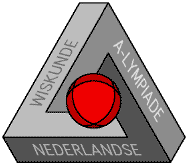 Math A-lympiad:
Preliminary 1995-1996
Math A-lympiad:
Preliminary 1995-1996
Elevators
Introduction
In 1995, a large company with 1200 employees moves into a new building.
This building has 21 floors: a ground floor and floors 1 to 20, and contains
six elevators in the central hall on the ground floor. All the employees
work on the first floor or higher and use the elevators to reach their
work floors.
In the first weeks, the number of employees entering the building every
morning generated enormous problems: not only getting hold of an elevator
but also the amount of time spent in the elevator caused unacceptable situations.
Sometimes an elevator was filled with employees all going to a different
floor. People going to the top floor sometimes need more than five minutes
to get there. People waiting for an elevator in the central hall, sometimes
in large numbers, all tried to get hold of the first one arriving and the
one closest to the entrance.
After a few weeks, an 'elevator supervisor' is hired by the board to
co-ordinate the stream of people arriving every morning. The supervisor
may do whatever he thinks is necessary to solve this problem.
First, the supervisor writes down all data concerning the problem:
-
60 people work on every floor (except the ground floor).
-
The capacity of each elevator is 20 people.
-
The velocity of the elevators:
| From one stand-still to the next, one floor higher or lower: |
8 seconds |
| From stand-still to passing a floor higher or lower: |
5 seconds |
| Amount of time between passing two floors: |
3 seconds |
| From passing a floor to stand-still at a floor higher or lower: |
6 seconds |
-
The minimum amount of time an elevator remains on a floor is 10 seconds.
The supervisor has gathered the following data on the morning-elevator-traffic:
-
All employees enter the building between 8.45 am and 9 am.
-
There is a steady stream of people: he assumes four employees of every
floor enter the central hall every minute.
To accelerate to process of getting the employees to their working floors,
he designs this model:
-
Three elevators only go to floors 1 to 10.
-
The other three elevators only stop at floors 11 to 20.
-
Between 8.45 am and 10 am, the elevators will only be used to transport
people who just arrived.
Exercise I
-
Calculate the amount of time it takes before every employee is on his/her
work floor.
-
Also check the maximum amount of people waiting in the central hall, at
any given time.
-
Find out how long it may take for an individual employee to go from the
entrance of the building to his/her floor.
There are of course a lot of other models you can think of, to improve
the morning-elevator-traffic. It is possible, for example, to decide that
half the elevators only stop at even floors and the other half at odd floors.
Exercise II
-
Think of at least three elevator schedules that will improve the morning-elevator-traffic.
Compare all schedules and point out advantages as well as disadvantages
to each schedule.
There are more ways possible to reduce the morning-elevator-traffic in
combination with an elevator schedule, for example:
-
Let people arrive at variable times in the morning.
-
Let people walk to certain floors.
Exercise III
-
Being the supervisor: write a recommendation for the board, in which you
offer suggestions to regulate the morning-elevator-traffic. Support this
recommendation with calculations and arguments. Also make your assumptions
clear.
One part of this recommendation should be a memo for the employees,
in which you inform them about the changes and explain what this will mean
to them.
In your model, you can choose to take into account that:
-
The employees don't want to be patronized too much, and the model mustn't
be too complicated. Still they all want to be on their work floors as soon
as possible.
-
The board has its office on the 15th floor and would like a preferential
treatment in the model.
 Math A-lympiad:
Preliminary 1995-1996
Math A-lympiad:
Preliminary 1995-1996 Math A-lympiad:
Preliminary 1995-1996
Math A-lympiad:
Preliminary 1995-1996